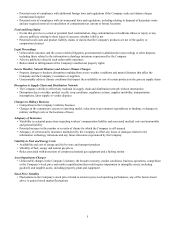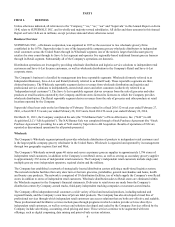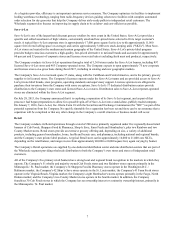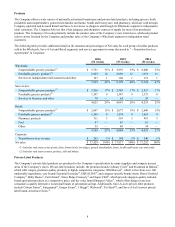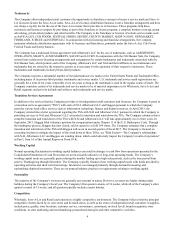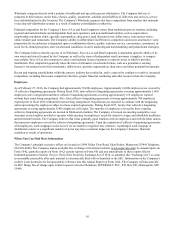Albertsons 2016 Annual Report Download - page 17
Download and view the complete annual report
Please find page 17 of the 2016 Albertsons annual report below. You can navigate through the pages in the report by either clicking on the pages listed below, or by using the keyword search tool below to find specific information within the annual report.15
• limit the Company’s ability to obtain, or increase the cost at which the Company is able to obtain, amendments to its
existing indebtedness or financing in order to refinance existing indebtedness and fund working capital, store growth
opportunities, capital expenditures, acquisitions and for other purposes;
• limit the Company’s ability to adjust to changing business and market conditions and to respond to market opportunities,
placing the Company at a competitive disadvantage relative to its competitors that have less debt.
A significant portion of the Company’s debt portfolio has a variable interest rate component. Volatility in interest rates causes
volatility in interest expense, potentially resulting in an adverse impact to earnings. Additionally, pursuant to the Company’s
debt agreements, the Company has created a security interest in substantially all of its assets to secure certain debt instruments.
The Company has also agreed to certain limitations on its ability to acquire or dispose of assets and is required to use the
proceeds of such dispositions to pay down its debt, subject to certain exceptions. There are also various restrictive covenants
and cross-default covenants in the Company’s debt instruments that could limit the Company’s operating and financial
flexibility.
If the Company fails to comply with any of these requirements, the related indebtedness (and other unrelated indebtedness)
could become due and payable prior to its stated maturity and the Company may not be able to repay the indebtedness that
becomes due. A default under the Company’s debt instruments may also significantly affect the Company’s ability to obtain
additional or alternative financing.
The Company’s ability to comply with the covenants or to refinance the Company’s obligations with respect to the Company’s
indebtedness will depend on the Company’s operating and financial performance, which in turn is subject to prevailing
economic conditions and to financial, business and other factors beyond the Company’s control. In particular, the Company’s
ability to obtain additional financing through the capital markets may be adversely impacted by global economic conditions.
Tightening of credit, low liquidity or volatility in the capital markets could result in diminished availability of credit and higher
costs of borrowing, making it more difficult for the Company to obtain or amend debt financing on favorable terms. These
conditions and factors may also negatively impact the Company’s debt ratings, which may increase the cost of borrowing or
adversely affect the Company’s ability to access one or more financial markets.
Any of these outcomes may adversely affect the Company’s financial condition and results of operations.
Increased healthcare, pension and other costs under the Company’s and multiemployer benefit plans, or failure to
maintain satisfactory labor relations, could adversely affect the Company’s financial condition and results of operations.
The Company provides health benefits to many of its employees and the costs of such benefits continue to increase annually.
The amount of any increase or decrease in the cost of Company-sponsored health plans will depend on a number of different
factors, many of which are beyond the Company’s control, such as The Patient Protection and Affordable Care Act, which has
resulted in changes to the U.S. healthcare system and imposes mandatory types of coverage and reporting and other
requirements on Company-sponsored health plans. If the Company is unable to control healthcare benefits and pension costs,
the Company may experience increased operating costs, which may adversely affect the Company’s financial condition and
results of operations.
The Company sponsors defined benefit pension, defined contribution pension, and other postretirement benefit plans for
substantially all employees not participating in multiemployer health and pension plans. The Company’s costs to provide these
benefits generally continue to increase annually. Additionally, the projected benefit obligations of the Company-sponsored
plans exceed the fair value of those plans’ assets. The Company uses actuarial valuations to determine the Company’s benefit
obligations for certain benefit plans, which require the use of significant estimates, including the discount rate, expected long-
term rate of return on plan assets, mortality rates and the rates of increase in compensation and health care costs. Changes to
these significant estimates could increase the cost of these plans, which could also have an adverse effect on the Company’s
financial condition and results of operations.
In addition, the Company participates in various multiemployer health and pension plans for a majority of its union-affiliated
employees, and the Company is required to make contributions to these plans in amounts established under collective
bargaining agreements. The costs of providing benefits through such plans have increased in recent years. The amount of any
increase or decrease in the Company’s required contributions to these multiemployer plans will depend upon many factors,
including the outcome of collective bargaining, actions taken by trustees who manage the plans, government regulations, the
actual return on assets held in the plans and the potential payment of a withdrawal liability if the Company chooses to exit a
market. Withdrawal liabilities could be material, and potential exposure to withdrawal liabilities may influence business
decisions and could cause the Company to forgo business opportunities. Increases in the costs of benefits under these plans,
coupled with both performance below the plans’ assumed rates of return in the equity and fixed income markets in past years


